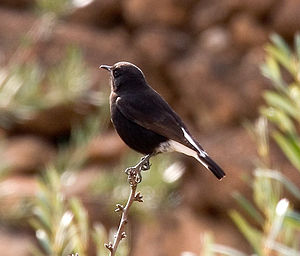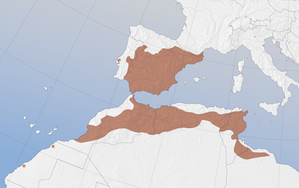Mourning Wheatear
| Mourning Wheatear | ||||||||||||
|---|---|---|---|---|---|---|---|---|---|---|---|---|

Black wheatear ( Oenanthe leucura ) |
||||||||||||
| Systematics | ||||||||||||
|
||||||||||||
| Scientific name | ||||||||||||
| Oenanthe leucura | ||||||||||||
| ( Gmelin , 1789) |
The Wheatear ( Oenanthe leucura ) or Trauerschmätzer is a bird art from the family of flycatchers (Muscicapidae).
description
With a length of almost 18 centimeters , the black wheatear is significantly larger than a wheatear ( Oenanthe oenanthe ) and shows predominantly black plumage, which is slightly shiny and intensely black after moulting, and duller during the breeding season. The rump and the under tail-coverts are white like the joint, the latter shows a conspicuous, black, terminal T-mark. The flight feathers are brightly lined. The female is very similar to the male, but usually more dull, brownish-black. The difference can usually only be seen in a direct comparison.
Due to its size and color, the black wheatear can be easily distinguished from other wheatears. It can only be confused with Saharan wheatear in the first year, which still lack the typical white cap. With these, the white fletching on the underside of the abdomen extends to the legs. In addition, the black tail drawing does not form a continuous band. The also very similarly drawn subspecies opistoleuca of Elstersteinschmätzers ( Oenanthe picata ) is much smaller and more delicate, dull black and shows no light feather fringes.
voice
The singing, which is performed from an elevated vantage point, consists of short, about a second long, quiet stanzas of melodic whistling or impure scratching sounds. When excited or in flight, the stanzas can be considerably longer. The imposing song that is performed during the "imposing dance" can contain imitations of other types in addition to creaking and trilling sounds. In conflict situations, even females can sometimes hear a soft vocal motif, and sometimes both partners communicate with soft, softer singing.
To warn of enemies of the ground, the wheatear gives a short, rough “Tschäk” or “grak” , with enemies of the air this is a plaintive “yü” or “jüb” , similar to the warning call of the blue bear . The excitement call is a high pitched “ pie-pie-pie” , “krirr” or “hihihihi” .
Subspecies and distribution
- Oenanthe leucura leucura ( JF Gmelin , 1789) - Pyrenees peninsula and southernmost France
- Oenanthe leucura syenitica ( Heuglin , 1869) - Northwest Africa east to northwest Libya
Way of life
The annual bird lives in rock deserts and mountains. The nest is built in caves between rocks. It consists of tightly woven blades of grass and roots that are carefully lined with goat hair inside. The entrance is often protected by a small wall of pebbles. The clutch consists of four to five eggs.
literature
- Urs N. Glutz v. Blotzheim, KM Bauer : Handbook of the birds of Central Europe. Volume 11 / I: Passeriformes. Part 2: Turdidae. AULA-Verlag 1988, ISBN 3-923527-00-4 .
- Roger Peterson, Guy Montfort, FAD Hollom: Die Vögel Europäische , Verlag Paul Parey, Hamburg and Berlin, 9th edition 1966, ISBN 3-490-05518-7
- M. Soler in WJM Hagemeijer, MJ Blair: The EBCC Atlas of European Breeding Birds - their distribution and abundance , T & AD Poyser, London 1997, ISBN 0-85661-091-7
- E. v. Viettinghoff-Scheel in E. Streseman et al .: Atlas of the Distribution of Palaearctic Birds , Delivery 2 (1967, PDF )
Web links
- Gender and age determination (PDF; 2.6 MB, English) by Javier Blasco-Zumeta and Gerd-Michael Heinze
- Oenanthe leucura inthe IUCN Red List of Threatened Species 2013.1. Listed by: BirdLife International, 2012. Retrieved September 15, 2013.
- Feathers of the weeping wheatear

